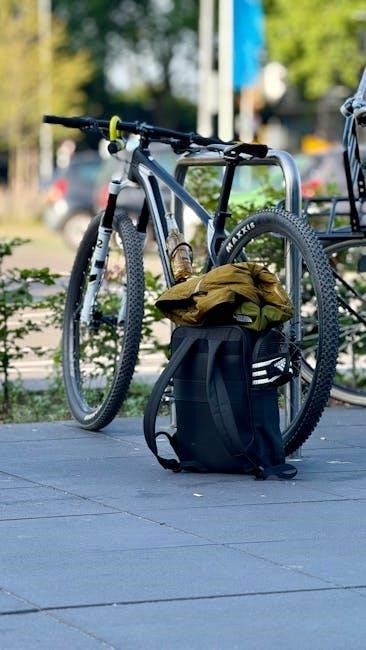Welcome to the ultimate bike guide! This guide helps you navigate the world of cycling by exploring various bike types, their features, and best uses. Whether you’re a seasoned rider or new to cycling, this resource ensures you make an informed decision when choosing the perfect bike for your needs.
1.1. Importance of Choosing the Right Bike
Selecting the right bike is crucial for safety, efficiency, and overall enjoyment. Each bike type is designed for specific terrain and riding styles, ensuring optimal performance. A road bike excels on paved roads, while a mountain bike is built for rough trails. Choosing the wrong bike can lead to discomfort, reduced performance, or even safety risks. Understanding your needs and preferences helps narrow down the options. This guide ensures you find a bike that fits your lifestyle, budget, and riding goals, making every journey more enjoyable and stress-free.
1.2. How This Guide Will Help You
This guide is your comprehensive resource for selecting the perfect bike. It breaks down the main types of bicycles, highlighting their features, pros, and cons. Whether you’re commuting, racing, or exploring trails, this guide offers tailored advice. It covers road bikes for speed, mountain bikes for off-road adventures, hybrid bikes for versatility, and more. By understanding your riding style and terrain preferences, this guide helps you make an informed decision. It also includes tips on budgeting, test rides, and maintenance, ensuring you find a bike that matches your needs and enhances your cycling experience.

Road Bikes
Road bikes are designed for speed and efficiency on paved surfaces. Lightweight frames, skinny tires, and aerodynamic designs make them ideal for racing, long-distance rides, and smooth roads.
2.1. Features and Characteristics
Road bikes are built for speed and efficiency, featuring lightweight frames, typically made from carbon fiber, aluminum, or steel. They have narrow, high-pressure tires that reduce rolling resistance, drop handlebars for multiple hand positions and aerodynamics, and a streamlined geometry for optimal performance. Gearing systems often include a wide range to tackle both flat terrain and climbs. Comfort is enhanced through ergonomic designs, while the aggressive riding posture maximizes power output. These bikes are designed for paved surfaces, emphasizing speed and endurance over versatility.
2.2. Pros and Cons of Road Bikes
Road bikes excel in speed and efficiency, making them ideal for long-distance rides on smooth surfaces. Their lightweight frames and aerodynamic designs reduce fatigue, while drop handlebars offer versatile hand positions. However, they are less versatile for rough terrain and lack the comfort of wider tires. Road bikes require a certain level of fitness and may not be as durable as other types. Despite these limitations, they remain a top choice for riders seeking performance and speed on paved roads.
2.3. Best Uses for Road Bikes
Road bikes are designed for speed and efficiency on paved roads, making them perfect for long-distance touring, competitive racing, and fitness training. They excel on smooth surfaces like bike lanes, highways, and racing circuits. Their aerodynamic design and lightweight frames allow riders to cover miles with minimal effort. For commuters seeking a fast and reliable option, road bikes are ideal. However, they are less suitable for rough terrain or carrying heavy loads. If your primary riding involves paved paths and speed is a priority, a road bike is an excellent choice.

Mountain Bikes
Mountain bikes are built for off-road adventures, featuring robust frames, wide tires, and advanced suspension systems. They excel on rough terrains like trails, hills, and rugged landscapes.
3.1. Features and Types (Hardtail, Full Suspension)
Mountain bikes are versatile and designed for off-road adventures. They come in two main types: hardtail and full suspension. Hardtail bikes feature a front suspension fork but a rigid rear frame, offering durability and efficiency on less technical terrains. Full suspension bikes have both front and rear suspension systems, providing superior comfort and control on rough trails. Hardtails are lightweight and cost-effective, while full suspension bikes excel in challenging terrains but are heavier and more expensive. Both types cater to different riding styles, ensuring optimal performance for various off-road conditions.
3.2. Advantages and Disadvantages
Mountain bikes offer excellent versatility for off-road adventures but come with specific trade-offs. Their durable construction and robust tires provide unmatched stability on rough terrain, making them ideal for challenging trails. However, they are heavier and less efficient on smooth roads compared to road bikes. While hardtail models are more affordable and easier to maintain, full suspension bikes offer superior comfort and control but are more expensive and complex to service. Despite these drawbacks, mountain bikes excel in their intended environments, making them a great choice for riders seeking thrilling off-road experiences.
3.3. Suitable Terrain for Mountain Bikes
Mountain bikes are designed for off-road adventures, excelling on rugged trails, rocky paths, and muddy terrains. They are ideal for navigating steep inclines, technical descents, and uneven surfaces. Whether it’s cross-country riding or downhill adventures, these bikes thrive in natural environments. Their wide tires and robust frames provide stability and control on loose gravel, dirt tracks, and forest trails. While they can handle light city rides, their true potential shines on challenging off-road terrains, making them perfect for riders seeking adrenaline-packed experiences in nature.

Hybrid Bikes
Hybrid bikes combine elements of road and mountain bikes, offering versatility for city commuting, fitness rides, and light off-road adventures. They provide comfort and practicality for various terrains.
4.1. What Are Hybrid Bikes?
Hybrid bikes are versatile bicycles designed to blend the best features of road and mountain bikes. They typically feature sturdy frames, medium-width tires, and upright handlebars for comfort. These bikes are ideal for commuting in urban areas, fitness riding, and light off-road excursions. Their design emphasizes practicality, making them suitable for a variety of riding conditions, from paved roads to gravel paths. Hybrid bikes are a great choice for riders who want a reliable and adaptable bicycle for everyday use without specializing in a single terrain type.
4.2. Benefits for City and Commuter Riding
Hybrid bikes excel in urban environments, offering a perfect blend of comfort, practicality, and efficiency. Their upright riding position reduces strain on the neck and back, while wide tires provide stability on uneven city streets. Lightweight frames and dependable braking systems make navigating traffic and stopping at intersections safer and easier. Additionally, hybrids often feature mounting points for racks and fenders, allowing riders to carry essentials securely. These bikes are ideal for daily commutes, offering a balance of speed and durability, making them a top choice for city and commuter riding.
4.3. Versatility in Different Riding Conditions
Hybrid bikes are designed to adapt to various riding conditions, making them a versatile choice for cyclists. Whether on paved roads, gravel paths, or light trails, their wide tires and durable frames provide stability and control. The upright riding position enhances visibility in traffic, while the lightweight design allows for easy maneuvering. Hybrids are equally suited for casual rides, fitness training, or running errands, offering a practical solution for riders who want a single bike for multiple purposes. Their adaptability ensures a smooth and enjoyable experience across different terrains, making them a great option for everyday use.

Electric Bikes (E-Bikes)
E-bikes combine traditional cycling with electric assistance, offering a versatile option for riders. Available in throttle and pedal-assist models, they provide effortless commuting, hauling cargo, or conquering hills with ease.
5.1. Types of E-Bikes (Throttle vs. Pedal-Assist)
E-bikes come in two main types: throttle and pedal-assist. Throttle e-bikes feature a handlebar control that activates the motor, allowing riders to accelerate without pedaling. This makes them ideal for heavy loads or steep inclines. Pedal-assist e-bikes, on the other hand, provide electric support only when the rider pedals, offering a more natural cycling experience. Both types cater to different needs, whether it’s ease of use or a more active ride. Understanding these differences helps in choosing the right e-bike for your lifestyle and terrain.
5.2. Advantages for Long Distances and Hills
E-bikes excel at tackling long distances and steep hills, making them a game-changer for cyclists. The electric motor provides consistent power, reducing fatigue on lengthy rides and enabling riders to conquer challenging terrain with ease. Whether commuting or exploring, e-bikes maintain a steady speed, ensuring efficiency and comfort. Their ability to handle inclines effortlessly makes them ideal for hilly regions, allowing riders to enjoy scenic routes without strain. This versatility and power make e-bikes a practical choice for both casual and adventurous cyclists seeking to expand their riding capabilities.
5.3. Maintenance and Battery Life Considerations

E-bikes require regular maintenance to ensure optimal performance and longevity. The battery is a critical component, with most e-bikes offering 400-1,000 charge cycles before capacity reduction. Proper charging habits, such as avoiding overcharging and storing in cool, dry environments, can extend battery life. Motor and brake systems also need periodic checks. Riders should follow manufacturer guidelines for servicing to maintain efficiency and safety. Battery life typically ranges from 30 to 70 miles on a single charge, depending on terrain and assistance level. Regular upkeep ensures reliable performance for years of enjoyable cycling.

Gravel Bikes
Gravel bikes are versatile, blending road bike efficiency with off-road capability. Designed for adventure, they feature wider tires, durable frames, and relaxed geometry, perfect for mixed terrain riding.
6.1. Features and Capabilities
Gravel bikes are designed with versatility in mind, offering a blend of road bike efficiency and off-road durability. Key features include wider, knobby tires (typically between 35-50mm) for better grip on loose surfaces, a lightweight yet robust frame, and a relaxed geometry for comfort on long rides. They often come with disc brakes for reliable stopping power in various conditions and mounting points for racks and fenders, making them ideal for bikepacking or commuting. This combination allows gravel bikes to excel on paved roads, dirt paths, and light trails, catering to both adventure-seeking and practical riders alike.
6.2. Best Terrain for Gravel Bikes
Gravel bikes excel on a variety of surfaces, making them highly versatile. They are ideal for mixed-terrain rides, including gravel roads, dirt paths, and light trails. Their wide, knobby tires provide excellent grip on loose or uneven ground, while their lightweight frames ensure efficiency on paved roads. Gravel bikes are perfect for adventures that combine smooth roads with rough, unpaved sections. They also perform well on fire roads, bikepacking routes, and even light singletrack. Whether commuting through the city or exploring remote landscapes, gravel bikes offer a balanced and capable riding experience for both practical and adventurous cyclists.
6.3. Comparison with Road and Mountain Bikes
Gravel bikes blend elements from road and mountain bikes, offering a unique compromise. Unlike road bikes, they feature wider tires and a more relaxed geometry, making them suitable for rough terrain. Compared to mountain bikes, gravel bikes are lighter and more efficient on paved roads. While mountain bikes excel on steep, technical trails, gravel bikes shine on mixed surfaces like dirt roads and gravel paths. They provide a versatile option for riders seeking adventure beyond asphalt but don’t need the suspension or aggressive geometry of a mountain bike, making them ideal for multi-surface exploration.

Specialty Bikes
Specialty bikes cater to specific needs, such as folding bikes for portability, cargo bikes for carrying heavy loads, and cruiser bikes for relaxed, stylish rides, offering unique solutions for diverse cycling requirements.
7.1. Folding Bikes
Folding bikes are designed for convenience and portability, making them ideal for commuters and city dwellers. They feature a compact, foldable frame that allows easy storage in small spaces. These bikes are lightweight and durable, with designs that prioritize practicality without compromising on performance. Folding bikes are perfect for those who need to combine cycling with public transport or have limited storage space. Their versatility makes them a popular choice for urban environments, offering a seamless transition between riding and carrying. They are also cost-effective and eco-friendly, aligning with modern sustainability trends.
7.2. Cargo Bikes
Cargo bikes, also known as box bikes or bakfiets, are designed for transporting goods, children, or pets. They feature a sturdy frame with a large rear platform or box, making them highly versatile for both personal and commercial use. These bikes are ideal for running errands, delivering goods, or family outings. Some models offer extended frames or two wheels for added stability and capacity. Cargo bikes are a practical, eco-friendly alternative to cars, promoting sustainable living while providing a fun and functional way to carry heavy loads efficiently.
7.3. Cruiser Bikes
Cruiser bikes are designed for comfort and style, offering a relaxed riding experience. They typically feature wide tires, a low-slung frame, and a single-speed or 3-speed drivetrain. These bikes are perfect for casual rides on flat terrain, such as beaches, parks, or neighborhood paths. Their upright riding position reduces strain on the back and shoulders, making them ideal for leisurely outings. Cruiser bikes often come with padded seats and decorative elements, emphasizing aesthetics alongside functionality.
They are a great choice for riders seeking a laid-back, enjoyable experience without the need for speed or off-road capabilities. Cruiser bikes are popular among those who prioritize comfort and style in their cycling adventures.

Tips for Choosing the Right Bike
Choosing the right bike involves assessing your riding style, budget, and terrain preferences. Test rides and professional advice can ensure the best fit for your needs.

8.1. Assessing Your Budget
Assessing your budget is crucial when selecting a bike. Prices vary widely, from a few hundred to several thousand dollars, depending on the type and quality. Consider how often you’ll ride and the terrain you’ll cover to determine where to invest. Road bikes and e-bikes tend to be pricier, while hybrid and city bikes are often more affordable. Set a realistic budget and stick to it to avoid overspending. Remember to factor in long-term costs like maintenance, accessories, and potential upgrades. Test rides and professional advice can help you find the best value within your price range.
8.2. Importance of Test Rides
A test ride is essential to ensure a bike is the right fit for you. It allows you to assess comfort, handling, and performance in real-world conditions. Pay attention to how the bike feels on different terrain and whether it suits your riding style. Test rides also help you evaluate features like gears, brakes, and suspension. Don’t rush—take your time to ride on familiar terrain and see how the bike responds. This hands-on experience is crucial for making a confident purchase decision and avoiding costly mistakes down the road.
8.3. Maintenance and Accessories
Regular maintenance is crucial to extend the life of your bike and ensure optimal performance. Simple tasks like lubricating the chain, checking tire pressure, and inspecting brakes can prevent costly repairs. Accessories like helmets, lights, and locks are essential for safety and convenience. Consider additional items such as water bottles, racks, and panniers for practicality. Investing in quality tools and accessories tailored to your bike type enhances your riding experience and ensures reliability. Proper care and the right gear make every ride safer, more enjoyable, and efficient, whether you’re commuting or exploring new trails.